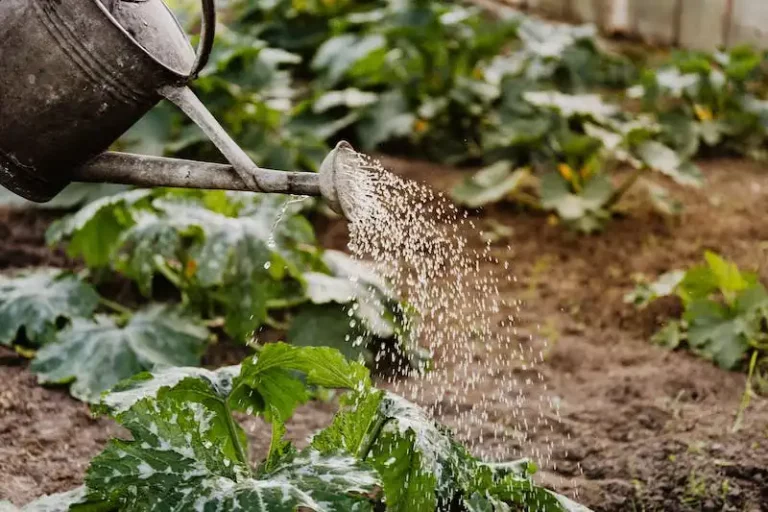If you have noticed bumps and unevenness in your lawn, you may be wondering what is causing these problems. It turns out that earthworm castings, one of nature’s wonders, may be the culprit.
Earthworms are a vital part of soil health and ecosystem management. They tunnel through the soil, aerating it and improving drainage. As they eat their way through organic matter, such as leaves and grass, they leave behind their castings – small mounds of soil and organic matter.
While earthworm castings are a sign that your soil is active and healthy, they can also be a nuisance. They can create a bumpy surface on your lawn, making it difficult to walk or mow. Additionally, the castings can turn into thatch, a layer of dead grass and other organic material, which can further complicate lawn care.
So what can you do about these bumpy earthworm castings? One solution is to regularly aerate your lawn. Aerators create small holes in the soil, allowing water, air, and nutrients to reach the grass roots more easily. This can help break up the castings and smooth out the bumps. You can also try raking the castings to spread them out more evenly.
Another option is to embrace the benefits of earthworm castings. They are a natural and organic amendment for your lawn, providing nutrients and improving soil structure. They can help your lawn stay healthy and green without the need for chemical treatments. Many lawn care professionals trust earthworm castings as a solution for turf management.
In conclusion, while earthworm castings may cause some bumpy problems for your lawn, they also have their benefits. It’s up to you to decide how to deal with them – whether it’s through aerators, raking, or embracing their organic goodness. Either way, understanding the effects and benefits of earthworm castings is key to maintaining a healthy and beautiful lawn.
Problems with Worms – Worm Casts in the Lawn
Worms are beneficial creatures that help improve the health of lawns and the overall environment. However, their presence can sometimes cause problems, particularly when it comes to worm casts in the lawn.
Worm casts are small mounds or lines of soil that earthworms create on the surface of the grass. While these casts may seem harmless, they can actually be quite problematic for lawn care. When left unattended, worm casts can make the lawn bumpy and uneven, making it difficult to maintain a smooth and attractive turf.
If you’re tempted to simply water the castings away, think again. While water may temporarily remove the worm casts, it can also create a muddy mess and potentially damage the grass in the process. Moreover, watering the lawn to remove worm casts is not a long-term solution, as the earthworms will continue to create new casts.
One of the benefits of worm casts is that they are rich in organic matter, which can provide valuable nutrients to the soil. However, excessive amounts of worm casts can lead to an imbalance in the nutrient levels and pH of the soil, which may affect the health of the grass. In addition, the casts can also contribute to the buildup of thatch, a layer of dead grass stems and roots, which can hinder water and nutrient penetration into the soil.
So what can you do to manage worm casts and keep your lawn looking its best? One solution is to regularly brush or rake the worm casts to break them up and distribute the soil evenly. This can help minimize their effects on the lawn and prevent the buildup of thatch. Alternatively, you can use a powdered sulphate of iron treatment, such as RainMaster, to dissolve the casts and improve the appearance of the turf.
It’s important to remember that earthworms are a sign of a healthy and active soil ecosystem, so outright getting rid of them is not recommended. Instead, focus on managing the effects of their activities on your lawn. By following these tips for identifying and dealing with worm casts, you can trust in nature’s own solution for a healthier and more beautiful lawn.
Quick Guide to Living with Earthworms
Earthworms are nature’s rainmasters, actively turning the soil and helping to control water and nutrient flow. While their castings may cause bumpy lawns, they provide numerous benefits to your grass and the environment. Here’s a quick guide on how to live with earthworms and manage the effects they have on your lawn.
Identifying Earthworms
Earthworms can be easily identified by their long, slim bodies and segmented appearance. They play a crucial role in maintaining soil health and fertility.
Understanding Earthworm Castings
Earthworm castings are the waste that worms produce. They are rich in organic matter and contain nutrients that are beneficial for your grass. Instead of seeing them as a problem, view them as a natural amendment that can improve soil quality.
Many people are tempted to get rid of earthworm castings by using aerators or dethatchers, but these can cause more harm than good. The best approach is to leave the castings on your lawn and let nature take its course.
Managing Bumpy Lawns
If the bumps caused by earthworm castings bother you, there are a few simple management techniques you can try:
- Rake the lawn to smooth out the bumps and distribute the castings.
- Top-dress your lawn with a thin layer of soil or compost to level the surface.
- Aerate the soil with a garden fork to improve drainage and help the castings break down faster.
Benefits of Earthworms
Earthworms provide several benefits to your lawn and garden:
- They improve soil structure by creating tunnels and channels.
- They increase nutrient availability by breaking down organic matter.
- They enhance water infiltration and drainage.
- They promote healthier root growth through their interactions with plants.
By trusting in the power of earthworms, you can have a thriving lawn without relying on synthetic treatments or harmful chemicals. Embrace these amazing creatures and reap the rewards they bring to your outdoor environment.
So, next time you spot a worm cast on your lawn, remember what’s really happening beneath the surface. Claire, the earthworm, is just doing her part to help repair and care for your grass!
Quick Guide to Worm Management
In Minneapolis, the bumpy lawns caused by earthworm castings are a common problem. While earthworms are beneficial for the soil, their casts can cause uneven terrain and interfere with the appearance and playability of your turf. To maintain a healthy lawn without compromising its smoothness, a few steps can be taken in worm management.
Understanding Earthworm Castings
Earthworm castings, also known as worm poop, are produced by earthworms as they digest organic matter found in the soil. These casts are rich in nutrients and beneficial microorganisms, making them a valuable soil amendment. However, when they accumulate on lawns, they can create bumpy surfaces.
Dealing with Worm Castings
If you are tempted to trust nature to take its course and let the casts break down on their own, there is a risk that the casts will accumulate over time, exacerbating the problem. To repair your lawn, you can follow these steps:
- Rid Your Lawn of Excess Castings
- Turn to Organic Amendments
- Control Worm Population
One effective solution is to manually remove the excess castings from your lawn. You can do this by raking them up or using a lawn roller to flatten the uneven surface.
Adding organic amendments, such as compost or peat moss, to your lawn can help improve soil structure and reduce worm activity. By creating a soil environment that is less favorable for worms, you can prevent excessive casting production.
To manage the worm population without causing harm, you can use natural control methods. Applying iron sulphate, for example, can deter worms from casting on the surface. However, it is important to carefully follow the instructions and avoid excessive use.
What’s the Bottom Line?
While earthworms are beneficial for your soil, their castings can cause bumpy lawns that require attention and care. By understanding how earthworm casts are produced and taking appropriate measures, you can maintain a healthy lawn without sacrificing its smoothness. Remember to regularly repair your turf, add organic amendments, and consider gentle methods of worm population control.
Having a well-maintained lawn throughout the year is possible with the right knowledge and treatment. Trust your lawn to professionals like RainMaster, who can help you deal with earthworm casts and other lawn problems.
Are Earthworm Castings Causing Your Bumpy Lawn? Are They Good or Bad?
If you’ve noticed that your lawn has become bumpy and uneven, earthworm castings may be the culprit. However, before you consider them a problem, it’s important to understand the role of earthworms and their castings in the environment.
Earthworms are nature’s own turf managers, and they play a vital role in improving soil health. They tunnel through the ground, aerating the soil and creating channels for water and nutrients to reach the roots of grass and other plants. As they digest organic matter such as leaves and dead plant material, they produce castings – worm waste that is rich in nutrients.
The Benefits of Earthworm Castings
Earthworm castings are considered an organic, all-natural fertilizer for your lawn. They contain a high concentration of essential nutrients, including nitrogen, phosphorus, and potassium, which are vital for healthy plant growth. The casts also improve soil structure, making it easier for roots to penetrate and absorb water and nutrients.
In addition to their nutritional benefits, earthworm castings help control thatch – a layer of dead grass, roots, and debris that can build up on the surface of your lawn. Thatch prevents water and air from reaching the roots and can lead to bumpy, unhealthy lawns. Earthworms break down thatch, reducing its accumulation and promoting better water and air circulation in the soil.
Furthermore, earthworms themselves are beneficial for your lawn. They are excellent soil conditioners, creating a healthy environment for beneficial microorganisms that help decompose organic matter and suppress harmful plant pathogens.
The Effects of Earthworm Castings on Your Lawn
While earthworm castings provide numerous benefits to your lawn, they can also contribute to the unevenness of the turf. Castings can build up over time, especially in areas with high earthworm activity, resulting in bumps and mounds on the surface of your lawn.
If you’re tempted to get rid of the bumps and smooth out your lawn, be cautious before taking any drastic measures. Earthworms are beneficial creatures, and using chemical treatments or excessive raking can harm them and disrupt the delicate balance of your lawn’s ecosystem.
Instead, there are a few natural methods you can try to manage earthworm castings. One option is to top-dress your lawn with a thin layer of sand or compost, which can help level out the bumps. Another option is to mow your lawn on a slightly higher setting to avoid cutting the grass too short and exposing the castings.
Dealing with Bumpy Lawns and Trusting Nature’s Way
In the end, having a slightly bumpy lawn due to earthworm castings is generally a small price to pay for the many benefits these creatures bring to your lawn and the environment. Their tunneling and nutrient cycling activities promote healthy grass growth and help keep your lawn naturally lush and green.
So, instead of fighting against earthworms and their castings, it’s better to embrace them as nature’s rainmasters and trust in their ability to create a healthy and beautiful lawn without the need for chemical treatments or excessive interventions.
| Benefits of Earthworm Castings | Effects of Earthworm Castings on Your Lawn |
|---|---|
| Organic and all-natural fertilizer | Potential unevenness and bumps |
| High concentration of essential nutrients | Possible cast buildup |
| Improves soil structure and aeration | Challenges in lawn maintenance |
| Controls thatch buildup | Potential harm to earthworms |
| Beneficial for soil microorganisms | Nature’s way of maintaining balance |




